BHARAT BHAYNA
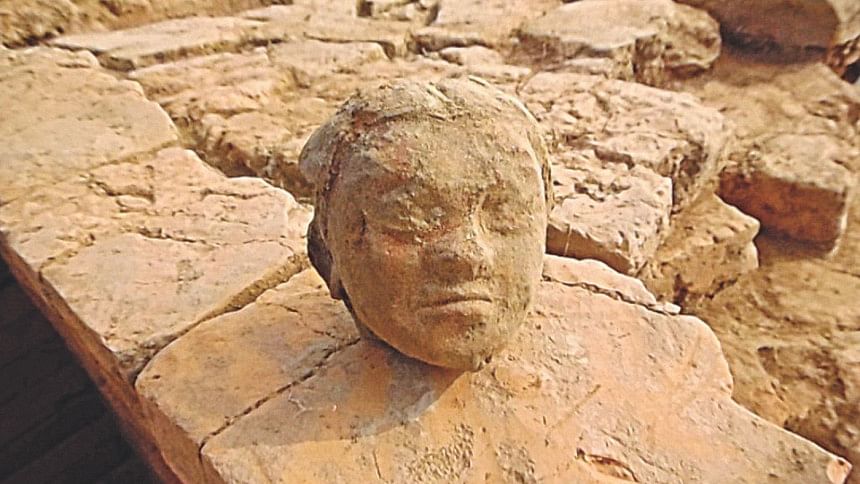
It was an evening of winter in December. The sun was hanging on top of the mound on its course to say goodbye for the day. The workers, who had been excavating since morning, wrapped up sometimes ago.
Now, inside the mound enclave, all are quiet. Adolescent boys, who were chatting, have left. The young couples, who were taking photos on top of the mound, are also gone.
Only the century-old banyan tree continues to stand by the mound, which is now being uncovered by the Department of Archaeology (DoA), for better display.
This is Bharat Bhayna. Locally known as Bharater (Rajar) Deul, the monument is said to be an early historic Buddhist temple, which was built between 5th and 6th century AD. The site had been under the soil for centuries, according to historians and archaeologists.
“This is the oldest site that has been found so far in the southwest region of Bangladesh,” said Afroza Khan Mita, regional director at Khulna of DoA.
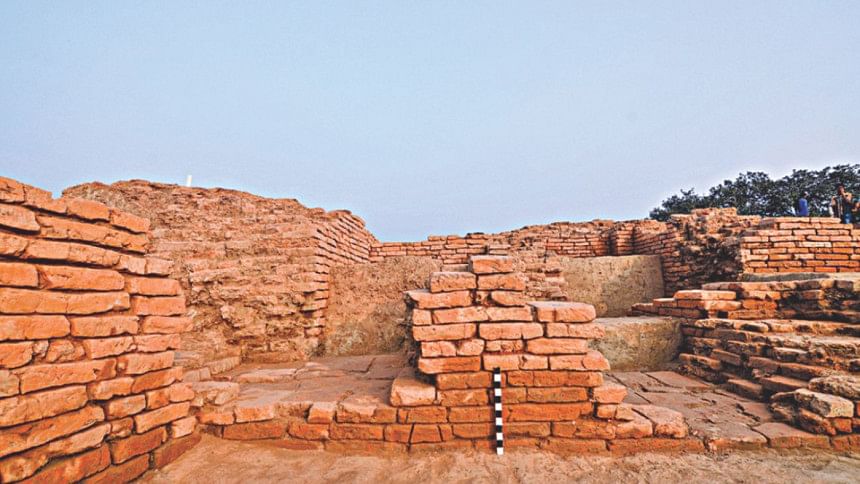
Since December last year, the DoA has been excavating for conservation parts of the mound so tourists and history students can have a better view.
Located in a remote village named Bharat Bhayna in Keshabpur upazila of Jessore, the temple is believed to be around 200 years older than Paharpur Boudha Bihar in Naogaon. Yet it remains to be a little known archeological site among the common people for a lack of publicity. Also, no major move was taken in the past to excavate to reveal its secret, archaeologists say.
Bharat Bhayna sits on the western bank of Buribhadra River flowing from south to north. On its south, an earthen walkway goes deep inside the neighbourhood while cropland and settlements occupy its western and northern side.
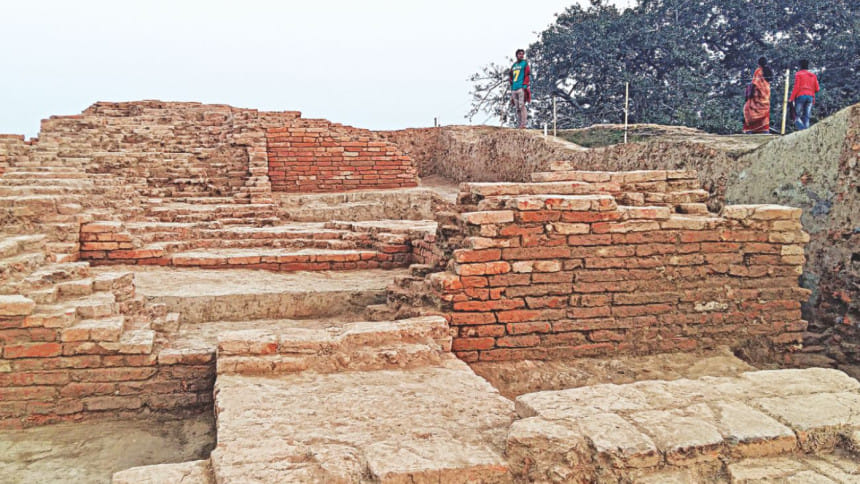
A fence constructed by the DoA keeps the site protected.
The mound, according to Banglapedia, raises 12.20 metre above the surrounding field and appears like a hillock in the plain land. It was much higher before the earthquake of 1897.
The circumference at the base of the fairly conical mound is about 250m.
The monument's significance was first shared by archaeologist KN Dikhsit in the Archeological Survey of India in 1922-23. Banglapedia, quoting Dikshit, said this was one of the 30 Sangharamas of Samatata mentioned by Hiuen-Tsang.
Some of the bricks here measure 16 inch*13inch*3inch, which bespeaks a high antiquity of the stupa.
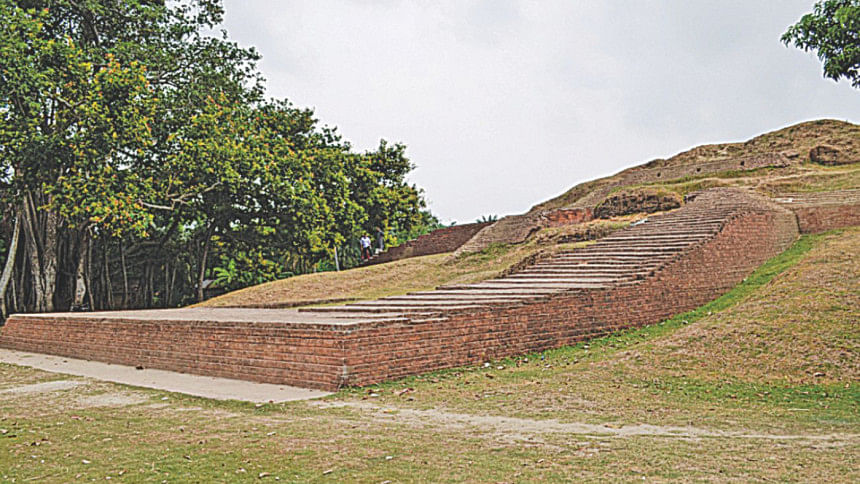
Comparing with this dimension with the dimensions of bricks of known periods found in the excavations at the Saheth–Maheth, it can be safely surmised that the stupa at Bharat Bhayna dates back at least from Gupta period, roughly the fifth century AD, said Dikhsit.
Satish Chandra Mitra, in his Jessore-Khulnar Itihas (A History of Jessore & Khulna District of Bangladesh), published in 1914, wrote people have named the pile as Bharat Rajar Deul.
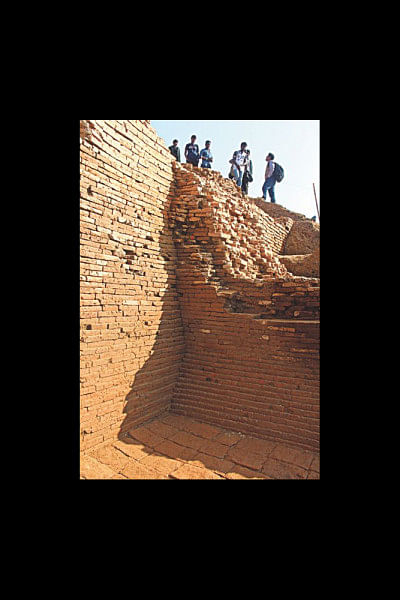
“Who is this Bharat,” he questioned to answer later, “It may be that a king named Bharat was ruling this part independently when anarchy began throughout Bengal ahead of Pala Dynasty.”
Ruins of houses of Bharat Raja were found at a nearby village Gourighona. “Two beautiful stones there give testimony of the past.”
In his book, Bangladesher Pratnasampad (Archeology of Bangladesh), Abul Kalam Muhammad Zakariah, citing his last visit in 1975, said no major change of the mound took place. “But land surrounding the mound has become plain and plenty of bricks are seen beneath the grasses.”
“Signs of wide trench still existed on the west and northern sides. By standing on the peak of the mound, one can easily conclude that the stupa was built at the centre of the area surrounded by river and trench.”
Back then, the whole of the land on the eastern part of the mound were cultivable. And there was no sign of remains of ruins of building on that part of the land. But brickbats and potteries were still visible.
A lot has changed since.
Large quantities of bricks have been taken away over time; homes built around the site.
But signs of trenches still exist on the northeastern side of the monument.
Archeological excavations were first conducted in 1923. After independence, the DoA first carried out excavations in 1985. The work was resumed after a decade in the year 1995-96 to continue up to 2000-2001 except for the year 1996-97.
As a result, vestiges of significant structural ruins have come into light, said Md Mosharrof Hossain in the Archaeological Survey Report on Greater Jessore in 2005, published by the DoA.
The report said the exposed structural ruins represent a single unit of buildings that rises in the three differently planned stages from the ground to the top that is cruciform, clustered cellular podium and nondescript type compartment.
“As such the whole structural planning demonstrates the idea of a building which in its original plan had a terraced rectangular superstructure (now totally lost) at its crest and raised platform below composed of blind cells with cruciform fencing around.”
“Thus conceptually, it resembles to such a building plan that was called Sarvatobhadra (four faced),” said Mosharraf in the Archaeological survey report.
Excavators earlier recovered terracotta Sivalinga of votive nature, a terracotta male bust, dabber, a terracotta female head, terracotta marble, cowrie and a few potsherds are worthy of note.
“Typologically, they belong to a period that ranges between the 5th and the 6th century AD,” the report added.
During the latest excavation for conservation, which began in early December, the DoA has recovered some broken pieces of terracotta plaques -- human head, body parts of animals such as head of bull, From this, it is assumed that terracotta plaques were used at the structure.
The excavation is done for now, and the DoA is working for preservation at the moment.
Archaeologist Mosharraf said Bharat Bhayna might have been built 300 years before Paharpur monastery, also known as Somapura Mahavihara.
So Bharat Bhayna might be one of the oldest archaeological sites after Mahastangarh, he said.
Mahsthan represents the earliest and the largest archaeological site consists of the ruins of the ancient city of Pundranagara, probably founded by the Mauryas.
On the reasons behind the lack of fame of Bharat Bhayna, Mosharraf said a lot of artifacts, sculpture and ornaments were found in Paharpur. But the number of artifacts recovered from Bharat Bhayna was insignificant. Besides, a lot have been written on Paharpur as it is listed as a world heritage site by the Unesco.
Also, the past governments did not pay much attention or allocate fund for better conservation of Bharat Bhayna. In fact, there hasn't been much excavation in the southwest region.
Construction of an on-site museum and a visitors' shed as well as publishing booklets on Bharat Bhayna might increase its appeal.
The DoA has already taken an initiative to build an on-site display centre, guard shed, toilets and develop other facilities for tourists. The department has also proposed acquiring 3.65 acres of land from the Jessore district administration.
“We have also started contacting local government authorities to improve the roads to Bharat Bhayna to facilitate easy movement of tourists,” said Afroza, the regional director at Khulna of DoA.
At present, one can go to the archaeological site both from Jessore and Khulna via Chuknagar by road.

 For all latest news, follow The Daily Star's Google News channel.
For all latest news, follow The Daily Star's Google News channel. 



Comments